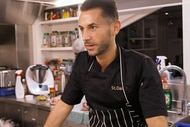
Create a free profile to get unlimited access to exclusive videos, sweepstakes, and more!
11 Common (and Sometimes Annoying) Things Food and Wine Experts Wish You'd Stop Doing Immediately
Love to snap photos of your food? Just say no.

You're no dummy when it comes to food and drink. You know the “right” way to cut a steak (against the grain, for optimal tenderness of course) and why you should always swirl a glass of wine before taking a sip (to bring out the aroma and enhance its flavor, natch).
But as clever as you are, it’s impossible to know everything. So we asked the people who do, in fact, know everything—from celeb chefs to sommeliers at Michelin-starred restaurants—for little-known tips and tricks you may not have heard before. Here, the experts share their most common pet peeves about the things we're doing wrong in the kitchen and at the dinner table.
1. Wasting Money on Expensive Salt
“Salt is salt is salt is salt,” says Jack Bishop, chief creative officer at America’s Test Kitchen. “Chemically, all salt is the same.” So what really gets his blood boiling is “when I see people putting expensive sea salt into water to boil pasta—they might as well be lighting dollar bills on fire,” he says. “It does absolutely nothing.” Duly noted.
2. Calling All Wines a “Varietal”
“The correct word is variety,” says Selena Cuffe, president and CEO of Heritage Link Brands and owner of Silkbush Mountain Vineyards in South Africa. “Merlot is a variety, Cabernet Sauvignon is a variety—‘varietal’ has a very specific meaning.”
She points to a post by The Kitchn to help explain the difference: “variety” is a noun, and refers to the grape variety used to make the wine (Chardonnay, Cabernet Sauvignon, etc.). “Varietal” is an adjective, and is used to describe wine that is largely made from one grape variety, but contains up to 15 percent of other grape varieties. “So ‘varietal’ can be correct,” Cuffe says, “but 99 percent of the time consumers don’t get the usage right.”
3. Not Sharpening Those Knives
Not only does a dull knife slow down your cooking—sometimes by as much as double, Bishop says—it also makes prep work dangerous, as a dull knife is much more likely to slip and cut your hand. “It also gives you poor results,” he adds. “If your cutting board is wet after chopping something like herbs or onions, then that means you’ve really bruised the hell out them and compromised the flavor. Your board should be dry.” If you cook every day, Bishop recommends sharpening knives once a week; once a month if you cook a few times a week.
4. Saving That Rosé for Summer
Rosé can pair with even the heartiest of winter or fall dishes, says Victoria James, beverage director for Piora and Cote in New York City and author of DRINK PINK: A Celebration of Rosé. “At Cote, a Korean-styled steakhouse, people tend toward red wine,” she says. “But when we steer them toward a powerful rosé that cuts through the rich meats and freshens the palate, they're thankful they branched out.”
5. Discarding the Seeds of Your Chili
Bishop detailed how America’s Test Kitchen ran lab tests to see where the heat of a chili comes from, and as it turns out, 98 percent is in the seeds and ribs. “At Test Kitchen, we always recommend separating the seeds and the ribs, mincing the chili and then modifying a dish’s flavor with the seeds,” Bishop says. “That’s the best way to control the spiciness.”
6. Serving Red Wine Too Chilled
By now many winos know to chill red wine slightly before serving, but just shoving it in your fridge is not the way to go. Doing so can “cause the aromas and flavors of the wine to be muted and will also cause the tannins to seem harsh and astringent,” says Erin Vaughen, founder of Vinley Market, an online wine club and boutique based out of Los Angeles. “A wine snob would therefore advise you to serve light, fruity reds at 50 to 60 degrees Fahrenheit and heavy, full-bodied reds at 60 to 65 degrees for optimal flavor.”
7. Forgetting the Phenomenon of Carryover Cooking
Food keeps on cooking after it comes off the grill or stovetop or out of the oven, so Bishop recommends taking food out 5, 10—sometimes 15 degrees, if it’s a really big cut—below the serving temperature. It'll continue cooking and reach optimal temperature even after it's removed from the heat.
8. Salting—or Instagramming—Your Food Before Eating It
OK, so this one may be more like a chef’s pet peeve—in fact, we heard this very gripe from a few—and you might be thinking, but only I know how much salt I like in a dish! Fair enough, but salting a dish before even tasting it takes away from how the chef prepared it. “Chefs, the lot of us, are sensitive egomaniacs, and we would like you to taste the dish as we intended before you choose to alter it,” says former Top Chef cheftestant Garret Fleming, head chef at Motto in Durham, NC, and cookbook contributor to A Meatloaf in Every Oven. “De gustibus non disputandum—that is, there's no accounting for tastes, but as a courtesy to the kitchen staff who made your meal, please try the dish first.”
Likewise, snapping a pic of your dish before even eating it is a chef no-no. “I also eat with my eyes and appreciate good-looking dishes, but they have to also taste great,” says Mimi Baines, head chef of New York’s Hole in the Wall Café and Bar and former MasterChef contestant. “To me, flavor will always come first to looks.”
9. Not Using the Spittoon at a Wine Tasting
We know, it looks gross—and why waste perfectly good wine? But according to John Cifelli, certified sommelier and general manager of Unionville Vineyards in Ringoes, NJ, the spittoon is your friend. “If your ‘tasting’ is really
a ‘drinking,’ your palate is quickly going to become clouded by the results
of intoxication,” he says, noting that drinking full tasting pours can quickly add up. “At that point you've lost the ability to discern the subtle nuances and flavors that make wine special, and you might buy a wine that, in the end, you realize you really didn't care for.”
10. Using Knives and Forks to Eat Barbecue
“Eat barbecue with your hands,” says Evan LeRoy, chef, pit master, and owner of LeRoy and Lewis Barbecue, in Austin, TX, the epicenter of barbecue country. “This is the way barbecue is meant to be eaten and enjoyed. You don’t need utensils for the experience.” LeRoy doesn’t just talk the talk—one of his favorite barbecue restaurants, Kreuz Market, in Lockhart, TX, doesn’t even offer patrons the option of forks and knives, even for those who order the brisket.
11. Pouring Beer Into a Tilted Pint Glass
“Pull out your nice, polished, cared-for wine glasses, and vigorously pour your beer straight down into the middle of it,” says Danny Bruckert, head brewer at Circa Brewing Co, opening soon in Brooklyn, NY.
Sacrilege, you say? Not so, says Bruckert. “What a world it would be if beer were treated with such respect! I drink all my beers this way if I'm able to,” he says, noting that almost any glass that is tapered toward the top is suitable. “For me, it’s the most satisfying way to enjoy a beer.”
That’s because Bruckert considers a stable, long-lasting head to be a gift from the brewer. “It directly relates to using high-quality ingredients and a careful attention during the brewing process,” he says, adding that this type of pour is sometimes referred to as the “7-Minute Pour” or “Pilsner Pour.”
It is, apparently, well worth the wait. “It will be more visually stimulating, and the vigorous agitation will release more CO2 that will carry more aromatics out of the beer,” he says. “The hardest part of the process is smelling all the beautiful and diverse aromas of the beer, while having to wait for the foam to settle. What cruel torture!”














